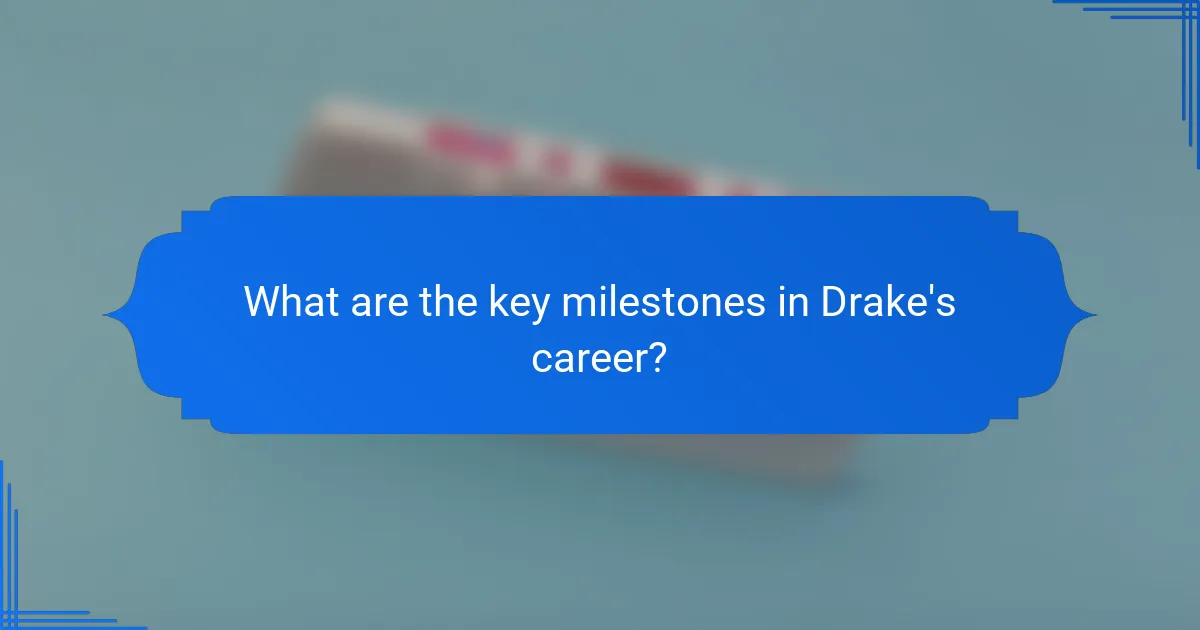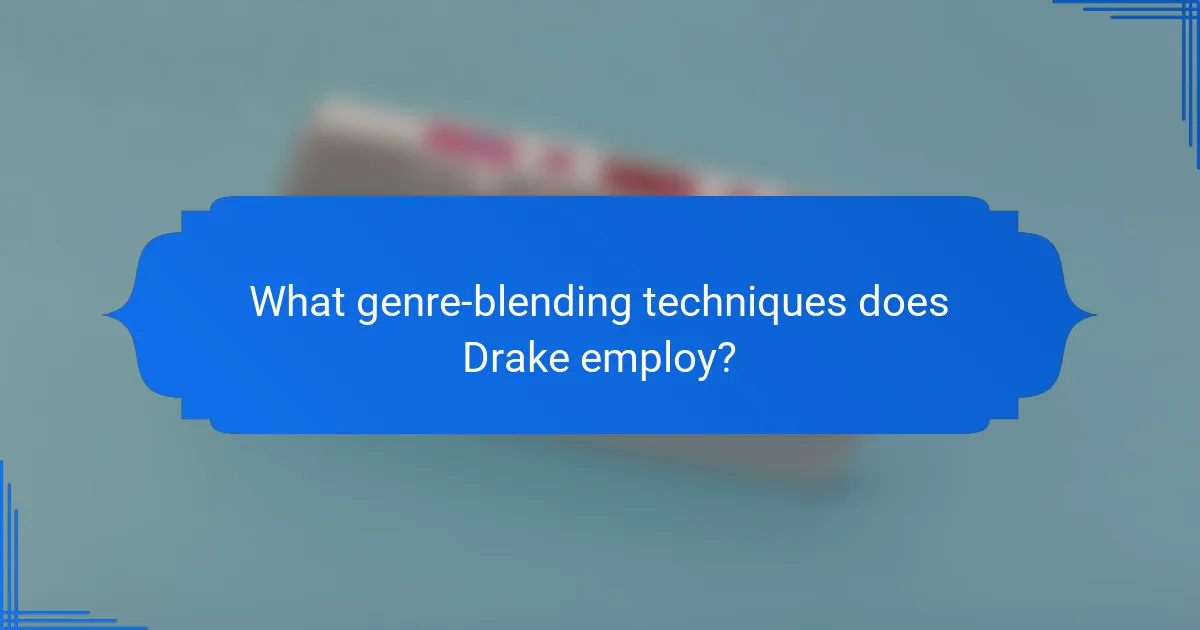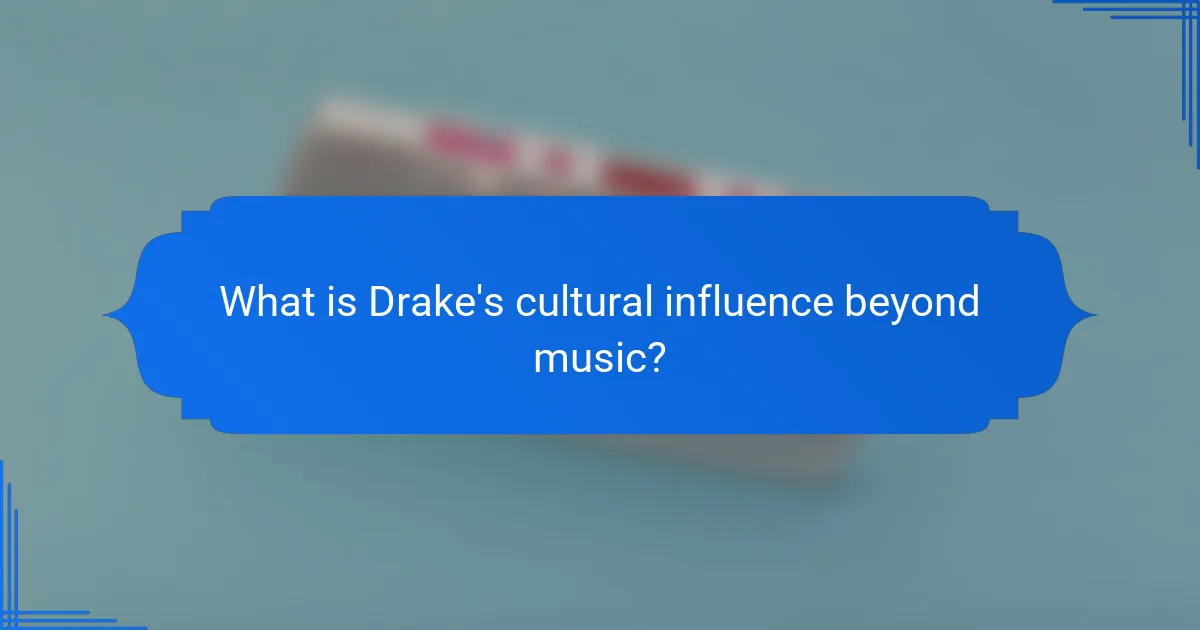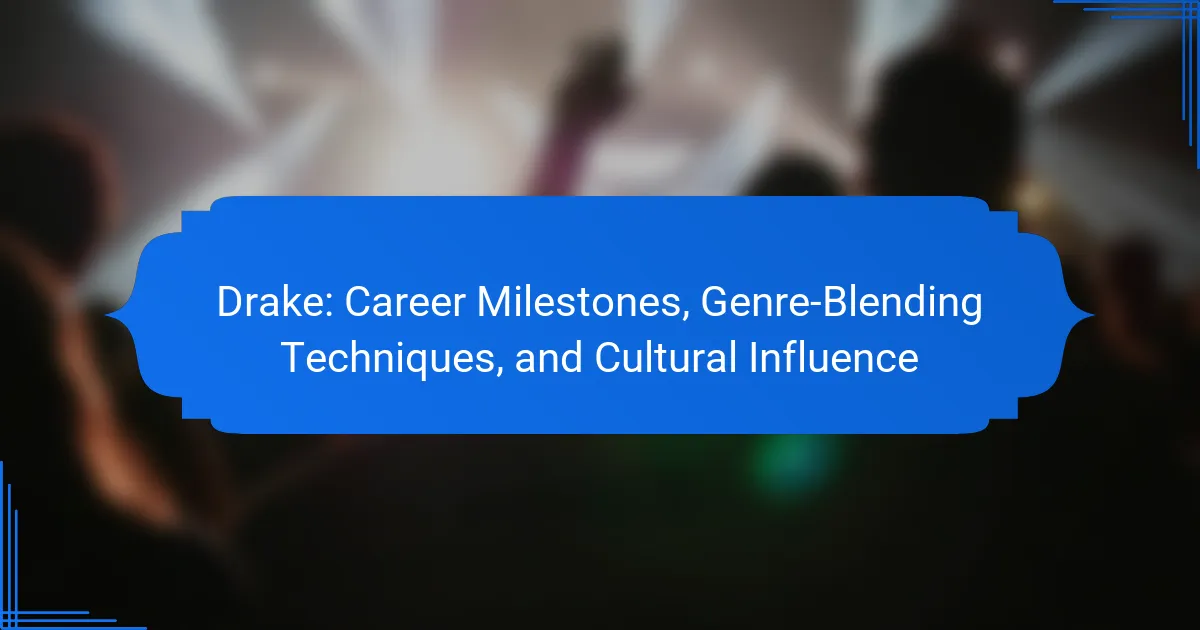Drake is a prominent figure in hip-hop, known for his significant career milestones and cultural influence. His rise to fame began with the 2009 mixtape “So Far Gone,” leading to successful albums such as “Thank Me Later,” “Nothing Was the Same,” and “Views,” each contributing to his commercial success and critical acclaim. Drake’s genre-blending techniques, which combine elements of hip-hop, R&B, dancehall, and pop, have created a unique sound that appeals to a diverse audience. Beyond music, he impacts fashion, social media, and popular culture, shaping trends and discussions while promoting emotional expression in hip-hop. His philanthropic initiatives and involvement in various media further extend his influence across multiple domains.

What are the key milestones in Drake’s career?
Drake’s career milestones include his initial rise to fame with the release of the mixtape “So Far Gone” in 2009. This project featured hit singles like “Best I Ever Had” and established him as a prominent figure in hip-hop. In 2010, he released his debut studio album “Thank Me Later,” which debuted at number one on the Billboard 200.
In 2013, Drake released “Nothing Was the Same,” further solidifying his status with tracks like “Started from the Bottom.” He achieved significant commercial success with the 2015 album “Views,” which included the global hit “One Dance.”
Drake’s 2018 album “Scorpion” broke multiple streaming records and included chart-topping singles. He has won four Grammy Awards and holds numerous Billboard chart records, including the most charted songs of any solo artist.
These milestones reflect Drake’s influence on hip-hop and his ability to blend genres, shaping contemporary music culture.
How did Drake rise to fame in the music industry?
Drake rose to fame in the music industry through his unique blend of hip-hop and R&B. He gained initial recognition with his 2009 mixtape “So Far Gone,” which featured hit singles like “Best I Ever Had.” This mixtape helped him secure a record deal with Lil Wayne’s Young Money Entertainment. His debut studio album, “Thank Me Later,” released in 2010, debuted at number one on the Billboard 200 chart. Drake’s ability to merge different musical styles attracted a diverse audience. He consistently produced chart-topping hits, earning multiple Grammy Awards. Collaborations with other prominent artists further expanded his reach. His innovative approach to music and marketing solidified his status as a leading figure in the industry.
What were the significant releases that marked his breakthrough?
Drake’s significant releases that marked his breakthrough include the mixtape “So Far Gone” and the album “Thank Me Later.” “So Far Gone,” released in 2009, featured hit singles like “Best I Ever Had” and “Successful.” This mixtape gained critical acclaim and commercial success, leading to Drake’s rise in the music industry. “Thank Me Later,” released in 2010, debuted at number one on the Billboard 200. It solidified his status as a leading artist in hip-hop and R&B. Both releases showcased his unique blend of genres and lyrical prowess, contributing to his cultural influence.
How has Drake’s career evolved over the years?
Drake’s career has evolved significantly since its inception. He began as an actor on the television series “Degrassi: The Next Generation.” In 2009, he released his breakthrough mixtape, “So Far Gone.” This mixtape featured hits like “Best I Ever Had,” which propelled him into the mainstream music scene.
Drake’s debut studio album, “Thank Me Later,” released in 2010, debuted at number one on the Billboard 200 chart. He continued to innovate with his 2011 album, “Take Care,” which won the Grammy Award for Best Rap Album. Over the years, Drake has mastered genre-blending, incorporating elements of hip-hop, R&B, and pop into his music.
His subsequent albums, such as “Nothing Was the Same” and “Views,” solidified his status as a leading figure in the music industry. He has set numerous records, including the most charted songs on the Billboard Hot 100. Drake’s collaborations with various artists have further expanded his influence across genres.
In recent years, he has embraced new sounds and trends, evident in his 2021 release, “Certified Lover Boy.” Throughout his career, Drake has maintained a strong cultural presence, influencing fashion, language, and social media trends.
What awards and recognitions has Drake received?
Drake has received numerous awards and recognitions throughout his career. He has won four Grammy Awards from 47 nominations. Drake is also a recipient of the Billboard Music Awards, with 27 wins. He holds the record for the most charted songs on the Billboard Hot 100. Additionally, he has received American Music Awards, including Favorite Rap/Hip-Hop Artist. Drake has been recognized by the Juno Awards, winning 13 times. He has also received accolades from the BET Awards, including Best Male Hip-Hop Artist. These awards highlight his significant impact on the music industry.
Which specific accolades highlight his impact on the music scene?
Drake has received numerous accolades that underscore his impact on the music scene. He has won four Grammy Awards, highlighting his excellence in music. Additionally, he holds the record for the most Billboard Hot 100 entries, with over 200 charted songs. Drake is also recognized as the first artist to surpass 50 billion streams on Spotify. His album “Views” was certified 6× Platinum by the RIAA, showcasing its commercial success. Furthermore, he has been named Artist of the Decade by Billboard for the 2010s, reflecting his influence over the decade. These awards and records collectively illustrate his significant contributions to the music industry.
How do these awards reflect his genre-blending capabilities?
Drake’s awards reflect his genre-blending capabilities through recognition in diverse musical categories. He has won Grammys in hip-hop, R&B, and pop categories. This demonstrates his ability to seamlessly integrate elements from various genres. His hit songs often combine rap with melodic hooks and R&B influences. For example, tracks like “Hotline Bling” showcase this fusion effectively. The awards highlight his innovative approach to music that transcends traditional genre boundaries. Additionally, his collaborations with artists from different genres further emphasize this versatility. The variety of accolades confirms his impact on the music industry as a genre-blending artist.

What genre-blending techniques does Drake employ?
Drake employs several genre-blending techniques that enhance his musical versatility. He seamlessly combines elements of hip-hop, R&B, dancehall, and pop. This fusion creates a unique sound that appeals to a broad audience. For instance, his song “One Dance” incorporates dancehall rhythms with hip-hop beats. Additionally, he often uses melodic hooks typical of R&B in his rap verses. Collaborations with artists from various genres further showcase his blending techniques. Tracks featuring artists like Wizkid and Kyla exemplify his ability to merge different musical styles. Drake’s genre-blending approach has contributed to his commercial success and critical acclaim.
How does Drake incorporate different musical styles into his work?
Drake incorporates different musical styles into his work by blending hip-hop with R&B, dancehall, and pop. This genre-blending creates a unique sound that appeals to diverse audiences. For example, his album “Views” features dancehall influences, while “Take Care” showcases introspective R&B elements. He often collaborates with artists from various genres, enhancing his versatility. Tracks like “One Dance” highlight this fusion, combining Afrobeats and dancehall. His experimentation with sounds keeps his music fresh and relevant. Drake’s ability to adapt to different musical trends contributes to his widespread popularity and critical acclaim.
What genres does Drake typically blend in his music?
Drake typically blends hip-hop, R&B, and pop in his music. His work often incorporates elements of dancehall and reggae as well. This genre fusion allows him to reach diverse audiences. For example, his album “Views” features both hip-hop beats and melodic R&B hooks. Additionally, tracks like “One Dance” showcase dancehall influences. Drake’s ability to blend these genres has contributed to his commercial success. His music often reflects contemporary trends in the music industry. This versatility makes him a prominent figure in modern music.
How does this blending affect the reception of his songs?
Blending genres in Drake’s music positively affects the reception of his songs. This approach attracts a diverse audience. By incorporating elements of hip-hop, R&B, and pop, he creates a unique sound. This uniqueness resonates with listeners across different demographics. His songs often chart well on multiple music platforms. For instance, “One Dance” topped charts in several countries. This genre-blending strategy enhances his mainstream appeal. It also allows for greater lyrical versatility. Consequently, his music frequently receives critical acclaim and commercial success.
Why is genre-blending important in Drake’s music?
Genre-blending is important in Drake’s music because it allows him to reach diverse audiences. By incorporating elements from hip-hop, R&B, dancehall, and pop, he creates a unique sound. This versatility enhances his appeal across various demographics. For example, his collaboration with artists from different genres broadens his listener base. Tracks like “One Dance” showcase this blending, achieving global chart success. Additionally, genre-blending reflects cultural influences, making his music relatable to a wider audience. It also sets trends within the music industry, influencing other artists to explore similar techniques. Overall, genre-blending is a key factor in Drake’s commercial success and cultural relevance.
What advantages does genre-blending provide for an artist like Drake?
Genre-blending provides significant advantages for an artist like Drake. It allows him to reach diverse audiences across multiple musical styles. By incorporating elements of hip-hop, R&B, pop, and dancehall, he attracts listeners from various demographics. This versatility enhances his commercial success, as evidenced by numerous chart-topping hits. For instance, his single “One Dance” topped charts in multiple countries, showcasing his genre-crossing appeal. Additionally, genre-blending fosters creative innovation, enabling Drake to experiment with sounds and collaborate with artists from different backgrounds. This approach keeps his music fresh and relevant in a rapidly changing industry. Overall, genre-blending strengthens Drake’s brand and solidifies his position as a leading figure in contemporary music.
How does genre-blending contribute to his unique sound?
Genre-blending significantly contributes to Drake’s unique sound by integrating diverse musical styles. His work combines elements of hip-hop, R&B, dancehall, and pop. This fusion creates a distinctive auditory experience that appeals to a wide audience. For instance, his use of melodic hooks from R&B enhances the emotional depth of his tracks. Additionally, incorporating dancehall rhythms adds a vibrant energy to his music. The seamless transitions between genres allow for greater artistic expression. This versatility has led to numerous chart-topping hits. As a result, Drake’s genre-blending approach sets him apart in the music industry.

What is Drake’s cultural influence beyond music?
Drake’s cultural influence extends beyond music into fashion, social media, and popular culture. He has collaborated with brands like Nike and OVO, shaping streetwear trends. His presence on social media platforms drives discussions and trends, making him a cultural icon. Drake’s phrases and memes often go viral, impacting everyday language. He has also influenced the portrayal of masculinity in hip-hop, promoting vulnerability and emotional expression. His philanthropic efforts, including the “God’s Plan” initiative, have raised awareness for social issues. Additionally, Drake’s involvement in television and film projects broadens his cultural footprint. His ability to blend genres has inspired artists across multiple music styles.
How has Drake shaped contemporary pop culture?
Drake has significantly shaped contemporary pop culture through his innovative music and cultural influence. His genre-blending techniques have popularized the fusion of hip-hop, R&B, and pop. This has led to a new sound that many artists emulate today. Drake’s lyrics often reflect personal experiences, resonating with a broad audience. His use of social media has transformed how artists engage with fans. He popularized the “Toronto sound,” bringing attention to Canadian hip-hop. Drake’s collaborations with various artists have expanded musical boundaries. His influence is evident in chart-topping hits and award nominations. Overall, Drake’s contributions have redefined modern music and cultural trends.
What trends has Drake initiated or popularized?
Drake has popularized the trend of emotional vulnerability in hip-hop. His lyrics often explore themes of relationships, heartbreak, and personal struggles. This approach has encouraged other artists to express their emotions more openly. Additionally, Drake has influenced the incorporation of various musical genres into hip-hop. He blends elements of R&B, dancehall, and pop, which has expanded the genre’s appeal. His use of catchy hooks and melodic flows has set a new standard in rap music. Furthermore, Drake has initiated the trend of strategic collaborations. He frequently collaborates with artists across different genres, enhancing cross-genre visibility. This has led to a more collaborative culture in the music industry. Lastly, Drake’s social media engagement has set a precedent for artists to connect with fans directly. His use of platforms like Instagram and Twitter has reshaped artist-fan interactions.
How does his public persona influence his cultural impact?
Drake’s public persona significantly influences his cultural impact by shaping perceptions of authenticity and relatability. His image as a vulnerable artist resonates with a wide audience. This relatability fosters a strong emotional connection with fans. Drake often shares personal experiences in his lyrics, enhancing this connection. His persona also embodies a blend of confidence and humility, appealing to diverse demographics. This duality allows him to cross cultural boundaries effectively. Furthermore, his active engagement on social media amplifies his influence, making him a prominent figure in contemporary culture. Research indicates that artists with relatable personas tend to have greater cultural resonance, as seen in studies on celebrity influence and fan engagement.
Why is Drake considered a cultural icon?
Drake is considered a cultural icon due to his significant impact on music and popular culture. He has consistently blended genres, including hip-hop, R&B, and pop, creating a unique sound that appeals to a wide audience. His album “Take Care” won the Grammy Award for Best Rap Album in 2013, showcasing his artistic credibility. Drake has broken numerous streaming records, including being the most-streamed artist on Spotify in 2015 and 2016. His influence extends beyond music, as he has shaped fashion trends and popularized phrases and memes. Additionally, his collaborations with diverse artists have further solidified his status in the industry. Drake’s ability to connect with fans through relatable lyrics has contributed to his cultural relevance.
What elements of his life and career contribute to this status?
Drake’s status as a prominent figure in music is attributed to his innovative genre-blending techniques. He seamlessly combines hip-hop, R&B, and pop, appealing to diverse audiences. His early career as an actor on “Degrassi” provided him with a unique platform and fanbase. The release of his mixtape “So Far Gone” in 2009 marked a significant milestone, propelling him into mainstream success. Drake’s ability to create relatable lyrics resonates with listeners, enhancing his cultural influence. He has broken numerous streaming records, showcasing his commercial success. Collaborations with various artists further broaden his reach and impact in the industry. His business ventures, including OVO Sound, demonstrate his entrepreneurial spirit and commitment to music.
How does Drake engage with social issues through his platform?
Drake engages with social issues through his platform by using his music and social media presence to raise awareness. He frequently addresses topics such as mental health, racial inequality, and gun violence in his lyrics. For instance, in his song “Duppy Freestyle,” he comments on the pressures of fame and personal struggles. Additionally, Drake has made public statements supporting movements like Black Lives Matter. He often collaborates with artists and organizations that focus on social justice. This engagement helps to amplify important conversations within popular culture. His influence reaches millions, making his platform significant for social discourse.
What practical insights can we gain from Drake’s career and influence?
Drake’s career and influence provide valuable insights into modern music marketing and audience engagement. His ability to blend genres has expanded the boundaries of hip-hop, attracting diverse listeners. Drake’s strategic use of social media has built a strong personal brand and direct fan connection. He frequently collaborates with various artists, showcasing the power of networking in the industry. His consistent chart performance illustrates the importance of adaptability in music trends. Drake’s storytelling in lyrics resonates with audiences, emphasizing authenticity as a key to success. His influence extends beyond music, impacting fashion and culture, highlighting the interconnectedness of creative fields.
How can aspiring artists learn from Drake’s genre-blending techniques?
Aspiring artists can learn from Drake’s genre-blending techniques by experimenting with different musical styles. Drake seamlessly incorporates elements from hip-hop, R&B, dancehall, and pop. This versatility allows him to reach a broader audience. Artists should analyze his collaborations with various artists across genres, such as Rihanna and Wizkid. They can also study how he mixes melodic hooks with rap verses. By doing so, artists can create unique sounds that resonate with diverse listeners. Drake’s success demonstrates the value of innovation in music. Emulating his approach can lead to greater artistic expression and marketability.
What strategies can be adopted from Drake’s approach to cultural engagement?
Drake’s approach to cultural engagement includes collaboration, authenticity, and adaptability. He collaborates with diverse artists across genres. This broadens his audience reach and fosters cultural crossover. Authenticity is central to his brand. Drake shares personal experiences in his lyrics, resonating with listeners. His adaptability allows him to evolve with changing musical trends. This keeps his work relevant and engaging. By embracing various cultural influences, he creates a unique sound. His strategies demonstrate the importance of connecting with audiences on multiple levels.
Drake is the primary entity of this article, which examines his career milestones, genre-blending techniques, and cultural influence. Key milestones include his rise to fame with the mixtape “So Far Gone,” the success of his debut album “Thank Me Later,” and numerous record-breaking releases like “Views” and “Scorpion.” The article highlights Drake’s innovative approach to blending hip-hop, R&B, and pop, which has significantly shaped contemporary music culture. Additionally, it explores his impact on fashion, social media, and social issues, illustrating how his career reflects broader trends in the music industry.
